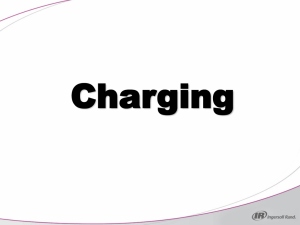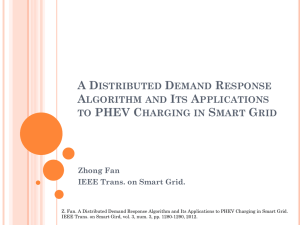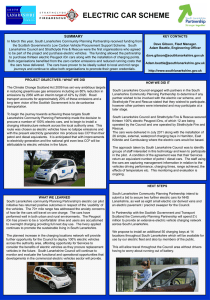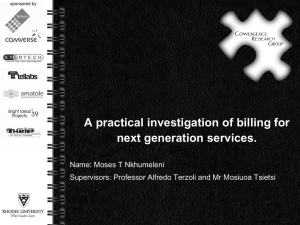DRIVING ELECTRIC AND YOUR CAR SCHEME
advertisement
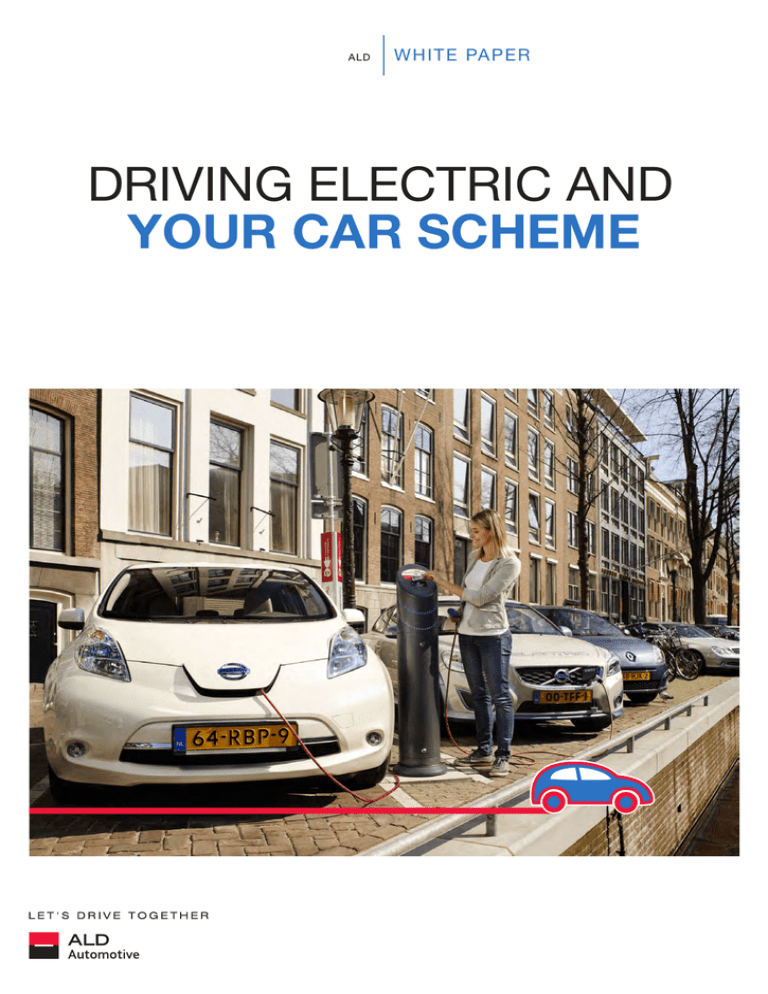
AL D WHI TE PAPE R DRIVING ELECTRIC AND YOUR CAR SCHEME TABLE OF CONTENTS Step 1. Policy 3 Step 2. Electric mobility attribution 3 Step 3. Brand policy and norm budget Step 4. Charging facilities at home and at work 3 4 Step 5. Calculating electricity and fuel costs 4 Step 6. Monitoring 5 Step 7. Additional services 5 Considerations besides the step-by-step plan 5 Finally, also important 6 More information or a consultation 6 SEVEN STEPS TO AN ELECTRIC-POWERED CAR SCHEME Driving electric is becoming more popular. More and more models are coming onto the market, and with increasing charging possibilities, driving electric is a serious option for more lease drivers. Since there is more to consider with electric cars than with fuel-powered cars, ALD Automotive has drawn up a step-by-step plan to include electric mobility in your car scheme and mobility policy. Step 1. Policy Step 3. Brand policy and norm budget Your mobility policy starts with determining your goals for using electric and semi-electric cars. That is the starting point for incorporating this into your car scheme. Goals could be: Brand policy The range of electric cars offered is steadily increasing, but not yet comparable with that of conventional fuel-powered cars. For this reason you should consider using a different brand policy for plug-in hybrids or electric models. The choice depends on the extent to which you want to encourage driving electric. • Saving on operational costs • CSR (CO2 footprint, particulate matter reduction) • Being an attractive employer Step 2. Electric mobility attribution The practicality of driving electric strongly depends on the travel behaviour of your employees and charging possibilities. The car scheme lets you determine whether an electric car is an option for everyone or that specific conditions apply for attribution, such as: Norm budget Due to the relatively high purchase price of electric cars, many models do not fit into the existing car scheme. When using a norm budget including fuel, choices increase. You should also consider exceeding the norm for fuel-efficient cars, including electric models, due to potential fuel savings. • Access to charging infrastructure: the presence of a charging point at home and/or at work or the possibilities thereof. • Driving profile: estimated distances people can drive electric based on the average annual amount of kilometres and commuting distance. 3 Your TCO calculation should also include the costs of the electricity, which the employer can compensate. A lease driver will less likely charge at home when they have to pay or advance the costs. For example, let us take a lease driver with a Mitsubishi Outlander PHEV who only charges at home starting from 12 kWh for a full battery and € 0,22 per kWh. It costs them € 2,64 per charging session at home, and if they do this on a daily basis, the costs are about € 74 a month. Charging at home You can compensate costs for charging at home in a number of ways: • You periodically pay out a set compensation, which is noted as salary or that is included in the expense allowance scheme. • You compensate the actual costs based on a separate electricity meter at the lease driver’s home and pay out the actual costs. • A smart charging station is placed at the lease driver’s home whereby the electricity costs are calculated directly. • You can also decide not to compensate it. Step 4. Charging facilities at home and at work The car scheme can determine whether the employer can facilitate a charging point or whether it is the responsibility of the employee. At work as well as home there are various possibilities, ranging from an ordinary outlet to a fast charging point. If you facilitate a charging point at home, it is then recommended to establish how you deal with the charging point in the event of damages or what to do with the costs of moving or the premature ending of your employee’s contract. It is not unusual that the costs for moving a charging point in these situations are partially charged to the employee. Step 5. Calculating electricity and fuel costs Electricity and fuel costs are an important part of your total mobility costs, as the lease driver has a major influence on this cost factor. For charging and filling the car you can issue a charging pass or combined filling/charging pass. This makes it easier for the lease driver and you have insight into total use costs. Charging at public points If the lease driver can charge at a public charging point at the home address, then a charging station does not need to be installed on their property. The charging costs at a public point are usually significantly higher than when power is used from the work or home address. In practice, it can be 30-50% higher. Due to the difference in providers of these points, the price per kWh and the starting rate may differ, among other things. Others can of course use the charging point, or a maximum charging time applies. Fuel filling To keep the fuel costs of semi-electric cars manageable, it is good to agree beforehand on filling with a plug-in hybrid and the use norm that you will apply. In practice we see the following applications: • No restrictions • Maximising filled fuel (L/month) • Maximising fuel use or the difference as compared to the fuel norm (l/100 km or %) • Bonus/malus arrangement, where extremely fuel-efficient drivers are rewarded and lesser fuel-efficient lease drivers must pay more. 4 The car scheme should state how and with what frequency any difference will be settled with the employee. You can also make driving even more interesting with a competition where the most fuel-efficient lease drivers are rewarded. Step 6. Monitoring Do you want to monitor the use? Then it is good to make this known beforehand to the lease driver, including the way in which you want to monitor this and any consequences of any ­deviations. Step 7. Additional services If you would like to encourage driving electric, you can among other things offer a holiday car for the periods that a semi-electric or electric car will not do. Offering an e-drive training can also positively encourage the use of a semi-electric or electric car. Considerations besides the step-by-step plan If you are actually considering adding electric mobility to your car scheme and mobility policy, then the example texts below should be useful to you. Finally, we have listed a few considerations and tips, which could help you or your lease drivers opt for electric mobility. Example texts ALD Automotive has drawn up a few example texts that you can include in your car scheme. company must be contacted. •A n employee must always use the charging systems meant for electric vehicles. During the use of a private charging station (installed or not by the employer), it is not allowed to have the cable run over the public road unless the owner of the private charging station has reached an agreement with the municipality and is insured against liability. •W ith the premature ending of the employee’s contract by the employee, they must pay back X% of the remaining costs of the home charging station. If the employee moves the costs for moving or removing the charging station will be charged to the employee as contribution for private use. •T he employee will be periodically informed about their fuel use. The employee is obliged to charge up a semi-electric car when possible and limit the use of the fuel-powered engine to a minimum. If the combined energy and fuel use differs more than X% from the factory norm, the employer is entitled to charge the additional use as personal contribution for private use. •T he charging point at home is not covered by the insurance of the employer or leasing company. In many cases the charging point comes under the home insurance of the house. The employee is responsible for insuring the charging station and for any damages to and/ or loss or theft of the charging station. If the ­employee must pay to insure the charging ­station, they will receive an annual compensation in instalments paid out monthly. •T he employer enables the employee to optimally use the semi-electric and electric car by providing a charging pass and offer enough charging possibilities at the office. The employee gets the option of a charging station at home should this be possible, which is advantageous for the employer. If a charging station is installed at home, the costs will be included in the leasing rate. In case of damages or outage of the charging station, the leasing 5 Finally, also important More information or a consultation • The electric range given by manufacturers only seems feasible in practice under ideal conditions. As a general rule, you can take 70% of the theoretical range as a realistic daily electric range. • Give potential drivers of electric cars a few days to test drive before you place an order. They will then experience what driving electric in everyday life will require of them. • As of 2016 road tax will probably have to be paid for semi-electric cars. Cars that now fall inside the leasing norm may exceed the norm. • Take into account that the compensation of power costs will be considered as salary and therefore taxed. A charging point with a separate metre or included in the expense allowance scheme could be a solution. We will gladly help you with implementing electric cars into your car scheme and fleet. Contact your usual contact person at ALD Automotive on +31 (0)20 658 70 00 or send an e-mail to info.nl@aldautomotive.com ALD AUTOMOTIVE P.O. BOX 696 2130 AR HOOFDDORP THE NETHERLANDS T +31 (0)20 658 70 00 F +31 (0)20 658 70 07 WWW.ALDAUTOMOTIVE.NL Subject to change. 2014 -1 6


